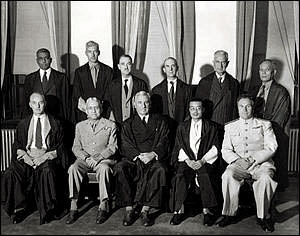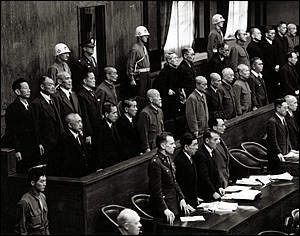Generals
Doihara, Kengi -death by hanging. Commander, Kwantung Army, 1938-40; Supreme War Council, 1940-43; army commander in Singapore, 1944-45. Deeply involved in the army's drug trafficking in Manchuria. Later ran brutal POW and internee camps in Malaya, Sumatra, Java and Borneo. Convicted on counts 1, 27, 29, 31, 32, 35, 36, 54.
Kimura, Heitaro-death by hanging. Chief of staff, Kwantung Army, 1940-41; vice minister of war, 1941-43; Supreme War Council, 1943; army commander in Burma, 1944-45. Helped plan the China and Pacific wars, including surprise attacks. Involved in the brutalization of the Allied POWs and was the field commander in Burma when civilian and POW slave labor built and died on the Siam-Burma Railway. Convicted on Counts 1, 27, 29, 31, 32, 54, 55.
Matsui, Iwane-death by hanging. Personal appointee of the emperor to the Geneva Disarmament Conference, 1932-37; commander, China Expeditionary Force, 1937-38. Troops under his overall command were responsible for the Rape of Nanking in 1937 and other atrocities. He retired in 1938 and then ceased to play an active role in military affairs. Convicted on Count 55. He was one of 14 Class A war criminals who were secretly enshrined as "matyrs" at the Yasukuni Shrine, which is dedicated to Japan's war dead and is Japan's most revered Shinto temple.
Muto, Akira-death by hanging. Vice chief of staff, China Expeditionary Force, 1937; director, military Affairs Bureau, 1939-42; army commander in Sumatra, 1942-43; army chief of staff in the Philippines, 1944-45. Troops under his command participated in both the Rape of Nanking and the Rape of Manila. Convicted on Counts 1, 27, 29, 31, 32, 54, 55.
Sato, Kenryo-life in prison, paroled in 1956. Sato, General Kenryo (1895-1975). Section head, then chief, Military Affairs Bureau, 1942-44; assistant chief of staff, China Expeditionary Force, 1944; army commander in Indochina, 1945. Convicted on Counts 1, 27, 29, 31, 32.
Umezu, Yoshijiro-life in prison, died in prison 1949. Section chief, general staff, 1931-34; commander, China Expeditionary Force, 1934; vice minister of war, 1939-44; army chief of staff, 1944-45. Convicted on Counts 1, 27, 29, 31, 32. |

